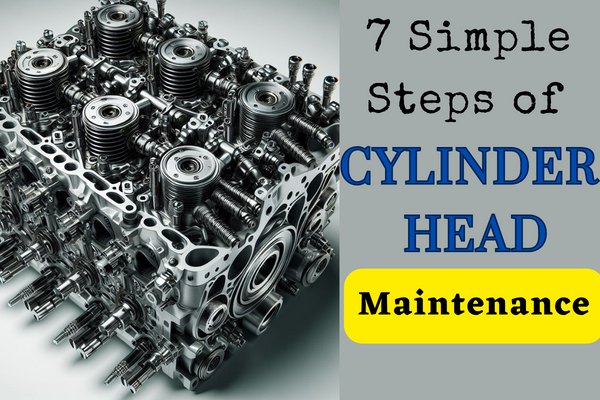Table of Contents
Toggle7 Easy Steps Of Cylinder Head Maintenance
Cylinder heads are essential components of any internal combustion engine, as they play critical roles in the intake, compression, combustion, and exhaust systems. Cylinder heads must be properly maintained to ensure maximum engine performance and lifetime. In this comprehensive tutorial, we’ll go over the necessity of cylinder head maintenance and provide step-by-step directions for keeping your engine operating smoothly.
Understand Cylinder Head Maintenance
Cylinder head maintenance consists of a series of operations designed to ensure the proper operation of the cylinder head and its associated components. Regular maintenance helps to prevent problems like leaks, overheating, and loss of compression, which can cause engine damage if left unchecked.
Inspection is one of the most important aspects of cylinder head maintenance. Regular inspections allow you to detect signs of wear, corrosion, or leaks early on, before they become more serious issues. During an inspection, look for cracks, warping, or other damage to the cylinder head, as well as the state of the valves, valve springs, and valve seats. Any irregularities should be handled immediately to avoid further engine damage.
Cleaning is another important part of cylinder head maintenance. Carbon buildup, dirt, and debris can gather on the cylinder head and its components, reducing performance and efficiency. Cleaning the cylinder head completely can help eliminate these deposits and guarantee proper airflow and combustion in the engine.
Steps of Cylinder Head Maintenance
Step:1- Inspection and Cleaning
Before beginning any maintenance tasks, check the cylinder head for signs of wear, corrosion, or accumulation. Examine the outside for cracks, leaks, or evidence of coolant or oil leaking. Also, remove the valve cover and check the interior for carbon buildup, sludge, or debris.
Step:2- Valve Adjustment
Proper valve adjustment is essential for preserving engine performance and avoiding valve damage. Use a feeler gauge to verify the clearance between the valve stem and the rocker arm. Adjust the valve clearance as necessary to guarantee optimal performance and avoid valve lash.
Step:3- Check and Replacing Gaskets
Check the cylinder head gasket for signs of wear, corrosion, or leakage. If any problems are found, repair the gasket to avoid coolant or oil leaks, which can cause engine overheating or damage. Check and replace other gaskets, such as the intake and exhaust manifold gaskets, as necessary.
Step:4- Cooling System Maintenance
The cooling system regulates engine temperature and prevents overheating. Check the coolant’s condition and flush the system on a regular basis to remove pollutants and debris. Inspect the hoses, clamps, and radiator for leaks or damage, and replace any damaged parts.
Step:5- Timing Belt/Chain Inspection
If your engine has a timing belt or chain, inspect it on a regular basis for symptoms of wear or damage. Replace the timing belt on the manufacturer’s recommended timetable to avoid catastrophic engine failure due to belt failure.
Step:6-Lubrication and Sealing
Lubricate all moving parts in the cylinder head, including the camshaft and valve stems. Use high-quality engine oil and lubricants to reduce friction and protect against premature wear. In addition, inspect and replace seals and O-rings to avoid oil leaks and ensure adequate sealing.
Step:7- Compression Test
A compression test is a helpful instrument for determining the condition of the engine’s cylinders and valves. A compression test can help detect problems including worn piston rings, valve seat troubles, and head gasket leaks. Conduct a compression test according to the manufacturer’s instructions and analyze the results.
Cylinder head maintenance is vital for keeping your engine running smoothly and reliably. By following these instructions and performing regular inspections and maintenance, you may extend the life of your engine and avoid costly repairs. Remember to emphasize safety and refer to your vehicle’s service handbook for particular maintenance requirements. With regular care and attention, your engine’s cylinder head will continue to function optimally for many miles to come.

4 thoughts on “Cylinder Head Maintenance”